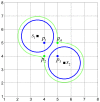On the deployment of a connected sensor network for confident information coverage
- PMID: 26007715
- PMCID: PMC4481968
- DOI: 10.3390/s150511277
On the deployment of a connected sensor network for confident information coverage
Abstract
Coverage and connectivity are two important performance metrics in wireless sensor networks. In this paper, we study the sensor placement problem to achieve both coverage and connectivity. Instead of using the simplistic disk coverage model, we use our recently proposed confident information coverage model as the sensor coverage model. The grid approach is applied to discretize the sensing field, and our objective is to place the minimum number of sensors to form a connected network and to provide confident information coverage for all of the grid points. We first formulate the sensor placement problem as a constrained optimization problem. Then, two heuristic algorithms, namely the connected cover formation (CCF) algorithm and the cover formation and relay placement with redundancy removal (CFRP-RR) algorithm, are proposed to find the approximate solutions for the sensor placement problem. The simulation results validate their effectiveness, and the CCF algorithm performs slightly better than the CFRP-RR algorithm.
Keywords: confident information coverage; connectivity; sensor placement problem; wireless sensor networks.
Figures






Similar articles
-
On Efficient Deployment of Wireless Sensors for Coverage and Connectivity in Constrained 3D Space.Sensors (Basel). 2017 Oct 10;17(10):2304. doi: 10.3390/s17102304. Sensors (Basel). 2017. PMID: 28994749 Free PMC article.
-
On Connected Target k-Coverage in Heterogeneous Wireless Sensor Networks.Sensors (Basel). 2016 Jan 15;16(1):104. doi: 10.3390/s16010104. Sensors (Basel). 2016. PMID: 26784201 Free PMC article.
-
Novel Visual Sensor Coverage and Deployment in Time Aware PTZ Wireless Visual Sensor Networks.Sensors (Basel). 2016 Dec 30;17(1):64. doi: 10.3390/s17010064. Sensors (Basel). 2016. PMID: 28042829 Free PMC article.
-
Wireless Sensor Network Optimization: Multi-Objective Paradigm.Sensors (Basel). 2015 Jul 20;15(7):17572-620. doi: 10.3390/s150717572. Sensors (Basel). 2015. PMID: 26205271 Free PMC article. Review.
-
The coverage problem in video-based wireless sensor networks: a survey.Sensors (Basel). 2010;10(9):8215-47. doi: 10.3390/s100908215. Epub 2010 Sep 2. Sensors (Basel). 2010. PMID: 22163651 Free PMC article. Review.
Cited by
-
Cuckoo-PC: An Evolutionary Synchronization-Aware Placement of SDN Controllers for Optimizing the Network Performance in WSNs.Sensors (Basel). 2020 Jun 6;20(11):3231. doi: 10.3390/s20113231. Sensors (Basel). 2020. PMID: 32517170 Free PMC article.
-
An Efficient Distributed Coverage Hole Detection Protocol for Wireless Sensor Networks.Sensors (Basel). 2016 Mar 17;16(3):386. doi: 10.3390/s16030386. Sensors (Basel). 2016. PMID: 26999143 Free PMC article.
References
-
- Akyildiz I.F., Su W., Sankarasubramaniam Y., Cayirci E. Wireless Sensor Networks: A Survey. Elsevier Comput. Netw. 2002;38:393–422.
-
- Wang B. Coverage Problems in Sensor Networks: A Survey. ACM Comput. Surv. 2011;43:1–56.
-
- Wang N., Zhang N., Wang M. Wireless Sensor in Agriculture and Food Industry-Recent Development and Future Perspective. Elsevier Comput. Electron. Agric. 2006;50:1–14.
LinkOut - more resources
Full Text Sources
Other Literature Sources

